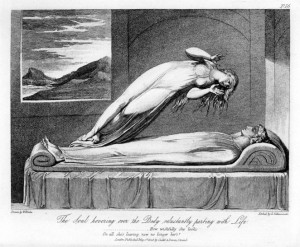When I was 23 years old I had the strangest dream. I remember it vividly even now, nearly 20 years on.
I was living in a cottage on the Isle of Arran, off the West Coast of Scotland, where I had taken myself to write a book. The cottage was a whitewashed old place on a farm, with walls made of two layers of local stone, with rammed earth between to keep the wind out. In order to open the windows in the thick walls, I had to stretch deep into the window alcove, nearly bending double to do so. Being so thick, the walls also kept out the sound of the outside. It was a silent space.
Upstairs, the bedroom had a wooden ceiling following the angles of the roof. At night, the window looked out on to dark, brooding fields, and a sky filled with bright stars. The full moon would cycle round once a month, shining a milky light on to my bed, with me in it.
I slept deeply in that room. The soughing of the wind in the gables was the only sound, except sometimes I would hear the scratching of a mouse scurrying up over the roof.
I was a sensitive soul, and I had gone up there partially to write a novel, and partially to be cured of a broken heart. I was a romantic wanderer, I suppose.
One night, I was lying deep, deep in sleep in this silent place. As I slept, I dreamt that the spirit of a woman came to me. She was a strange creature, with a face as white as moonlight. She wore a winding sheet – or if not that – then a floating white cotton night dress. Her face was cold and she looked at me with a definite intent, though to do what I could not be sure. Her hair was blonde – not white blonde – but the colour of ripe straw. If I were to say that she was anything, then she seemed like a goddess of the wheat. And I don’t mean that she was a spirit from a bottle of fermented barley.

She floated closer, hovering over me, and I could feel her cold breath on me. I realised that she was going to float down and smother me. And it was then that I woke up with a short, sharp gasp, staring into the night.
And as I looked, she was still there in front of my eyes, lowering herself towards me.
I found that I could not move, and as she came closer, I tried so hard to cry out. But somehow I was held in a helpless trance, unable to move and unable to scream. I was shaking with fear. I could hear my heart pounding in my ears as her body and face pushed closer. I knew something terrible was going to happen.
And then, her body touched mine. And she continued to sink down until she completely disappeared inside of me.
As she did so, I felt a huge wave of resignation and relief wash through me. I had a feeling as if of an unwinding of a massive tense spring in my stomach, and I suddenly felt grateful and happy for her presence.
She has stayed with me, inside of me for years now. There are times when I feel that I have lost her. But she comes back when the time is right. When I am in contact with her, I feel at my most confident. I am able to organise my thoughts, and I am able to write coherently and from the heart.
I have no idea who she is, except that she is me.
Dreams are the strangest things. I do not know what that dream was, nor do I want to know, but thanks to that dream I am more comfortable in my skin than I ever was before. That dream marks the time when I stopped being a boy and I became a man. It is also the time from which I count my life as a writer.
All of this, thanks to the woman inside of me.



